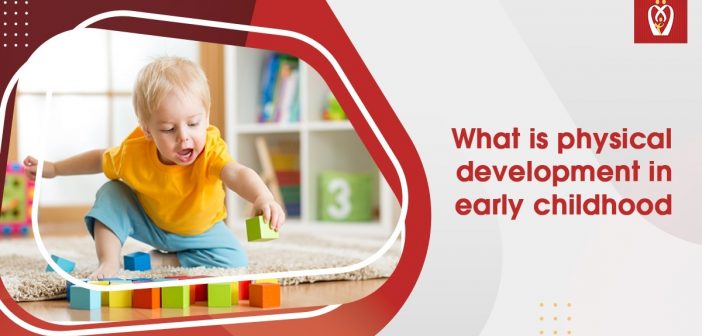Children grow rapidly between the ages of one and two, but once they reach the age of two, toddlers’ growth slows down. This occurs when parents become concerned about their child’s shifting eating habits and wonder if they are growing normally.
During infancy, physical development in children occurs in a succession of growth spurts. It’s vital to remember that the child will continue to develop at a regular and consistent rate until puberty after the growth spurts. The easiest method to tell if your child is growing normally is to keep a careful eye on him and chart his progress.
What Is Physical Development in Children and Why Is It Important?
Your child is slowly but steadily preparing to take on a structural build that is practically identical to that of an adult. This is referred to as physical development in children.
Physical Development in children signs
The following are some of the more obvious markers of a physical development in children:
1.Limbs
The child’s limbs and legs will lengthen and become proportionate to their body and head. You’ll also notice that your child is much smaller and thinner than he was when he was a baby.
2.Muscle Development
Muscle growth will be accelerated to let the youngster move more freely. The larger muscles in the arms and legs will grow faster than the tiny muscles in the toes and fingers. To aid the growing process, it is critical to ensure your child consumes allthe proper nutrients at this point.
3.Development of the Brain
Your child’s brain will develop, allowing them to accomplish more difficult mental and physical tasks. The nerve fibres in the brain, particularly in the frontal lobes, expand rapidly during early life. . This growth can be attributed to an increase in motor abilities. It is another usual practice to calculate the brain’s growth rate by measuring the size of the head.
4.Hand-eye coordination
The ability of a youngster to do tasks daily is linked to their motor abilities. Anything from running to constructing blocks can be used. There are three types of motor skills:
Gross Motor Skills
These skills, also known as essential motor skills, are required to do general actions such as running, walking, jumping, or even balancing their bodies while participating in these activities.
Your youngster should be able to do some of the following activities with gross motor skills:
- Maintain a steady equilibrium when walking.
- Run in a single direction or around obstacles with ease.
- Catch a ball or throw one
- Objects or low-lying barriers can be jumped over.
- Kick a ball that isn’t moving.
- Ride a tricycle.
Fine Motor Skills
These tiny motions, often known as minor motor abilities, must complete slightly challenging tasks. These are also linked to a child’s cognitive development.
A child’s fine motor skills enable them to:
- Cutlery should be used.
- Brush your teeth or comb your hair.
- Pick up small objects such as coins.
- Simple puzzles to solve
- Simple shapes, such as circles and squares, should be drawn.
- Assemble the blocks.
-
Height
By 12 months, the length of an infant is known to be about 50% of the birth length. Therefore, children should be twice their birth length when they reach the age of five. Also, at roughly 24 months, boys attain half their adult height, while girls reach half their adult height at around 19 months.
-
Weight
The infant’s weight will be three times that of their birth weight by the age of one year. After the first year, his growth rate slows down, and he will gain roughly 2 kg each year between one and six years.
-
Teeth
Your baby’s bottom front teeth should appear around the age of five to nine months. The top front teeth appear between the ages of eight and twelve months. By two and a half years, most children have all 20 of their baby teeth, also known as deciduous teeth. Between the ages of 5 and 13, permanent teeth replace baby teeth.
Physical Development Stages – will add how to modify this based on our app by EOD
Physical development in children follows a predictable pattern:
- By nine months, babies can crawl, sit, and hold their heads up.
- Between the ages of two and four, they learn to walk, run, leap, climb stairs with assistance, assemble blocks, and grasp crayons.
- They can climb stairs, write, and even dress between the ages of four and six.
- Ways to Help Toddlers and Preschoolers Develop Physically
- To increase your child’s skill and overall development, incorporate some activities to help physical development in children
- Take a walk with your child and let him run, jump, and exercise his muscles.
- Make an introductory obstacle course for your youngster to jump over, or encourage him to run about the house or garden.
- With a ball, play catch. You can also play games where your child kicks and throws the ball, strengthening his muscles and improving his motor abilities.
- Take your child on a walk in the woods. Allow him to touch the grass, leaves, and flowers by stopping now and again. Solicit pebbles and twigs from him. These activities will assist your youngster in developing their gross and fine motor skills.
- Throw a dancing party at your house. Put some music on and dance with your child, particularly to nursery songs that encourage fine motor abilities, such as “itsy bitsy spider.”
- Play imaginary activities, such as balancing on a tightrope laid out on the ground.
- Use art to express yourself. For example, allow your child to draw in and around the house as much as possible.
- Get some child-safe scissors and show your youngster how to do different crafts.
- Organize a block-building competition.
- With your infant, play a simplified version of ‘Simon Says.’ If you’re Simon, your youngster must do all you ask of him – take advantage of this opportunity to make him get things, pick up stuff, and even act out other animals like ducks, cows, dogs, and monkeys.
- Get your youngster a tricycle, a basketball hoop (child-sized), or hula hoops, which can help with physical development in children.
- Fill a tiny inflatable pool with water and play with it. Allow your toddler to splash or paddle while you supervise.
- Get your child to jump on a trampoline or a bouncy castle. Ensure that he is under the supervision of an adult during this activity.
- Allow your child to assist you with simple, enjoyable tasks such as shampooing the dog or washing the car.
- Assist your child’s general growth by ensuring that they get enough sleep.
- Take the youngster to the doctor regularly to catch any developmental problems early.
- Physical development in children should be accompanied by good nutrition and a well-balanced diet since this enables proper muscle and bone growth and development.




